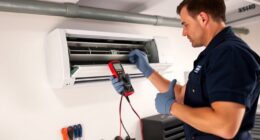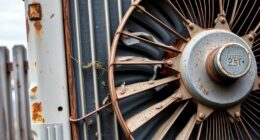Using heat pumps without ductwork is an excellent choice for historic homes, as it avoids invasive modifications that could damage original features. Ductless mini-split systems are flexible, energy-efficient, and discreet, allowing you to maintain your home’s character while enjoying effective heating and cooling. Proper installation by experts guarantees minimal impact on architectural details. To discover how to integrate these solutions seamlessly into your property, explore further for detailed tips and options.
Key Takeaways
- Ductless heat pumps eliminate the need for invasive ductwork, preserving the architectural integrity of historic homes.
- Indoor units can be discreetly mounted to blend with original features, maintaining aesthetic appeal.
- Proper installation by professionals ensures minimal disruption and adherence to preservation standards.
- These systems are energy-efficient, reducing costs while avoiding structural modifications.
- Upgrading insulation enhances heat pump performance, maximizing comfort without damaging historic elements.
Understanding the Limitations of Traditional Ducted Systems in Historic Homes
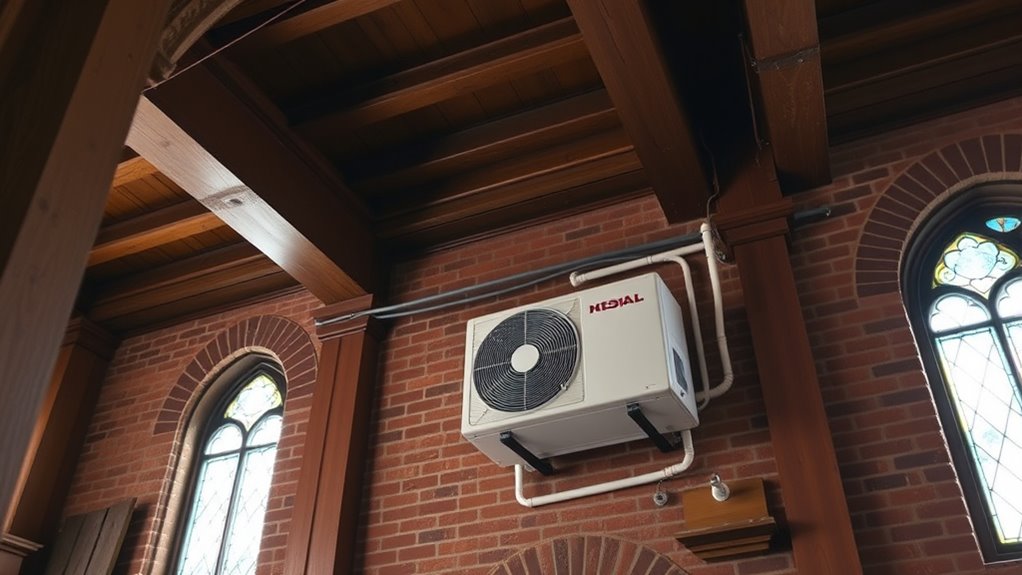
Traditional ducted HVAC systems often pose significant challenges in historic homes because these properties typically lack the space or infrastructure needed for ductwork. Installing central heating can be invasive, damaging original features and compromising the home’s integrity. Furthermore, existing insulation may be insufficient, causing heat loss and making it hard to maintain consistent temperatures. Ductwork installation often requires tearing into walls or ceilings, which can be costly and disruptive. These limitations highlight why traditional systems aren’t ideal for heritage properties. Instead, upgrading insulation can improve energy efficiency, but without proper ductwork, heat distribution remains uneven. Understanding these constraints is essential when exploring alternative heating solutions that preserve your home’s historic charm while providing reliable warmth. Additionally, signs of spoilage in existing heating components should be checked to ensure safety and efficiency.
Exploring Ductless and Mini-Split Heat Pump Options for Heritage Properties
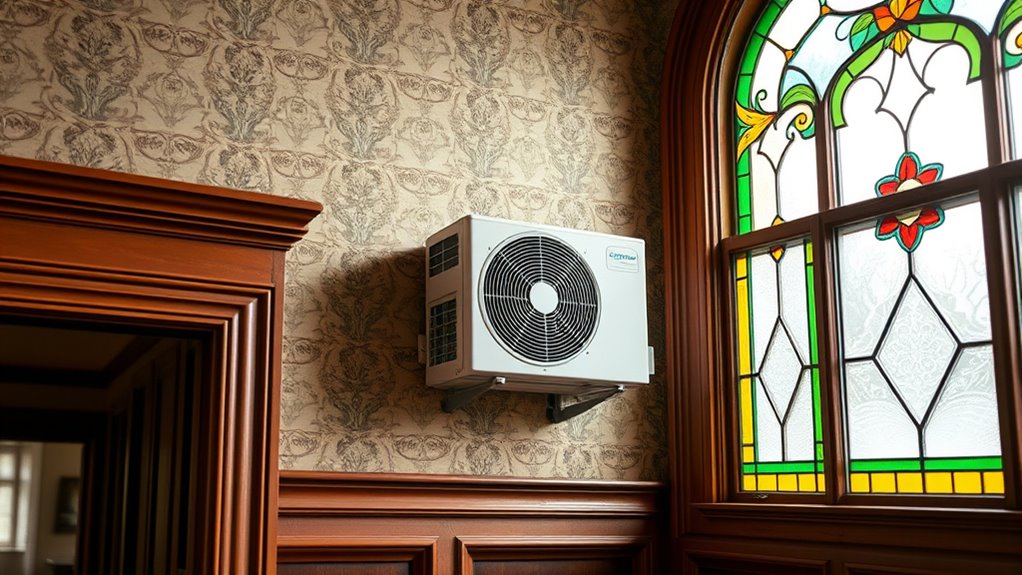
Ductless and mini-split heat pumps offer flexible installation options that work well in historic homes without ductwork. They also blend seamlessly with your property’s aesthetic, minimizing visual impact. Plus, they can be cost-effective and energy-efficient, making them a smart choice for preservation-friendly heating solutions. Additionally, self watering plant pots demonstrate how innovative solutions can enhance functionality while maintaining aesthetic integrity in sensitive environments.
Installation Flexibility Options
When working with historic homes that lack existing ductwork, installing a heat pump can seem challenging, but flexible options make it easier than you might think. Duct system limitations and historic preservation constraints often restrict traditional HVAC upgrades, but ductless and mini-split systems offer versatile solutions. These units don’t require extensive ductwork, making installation simpler and less invasive. You can position indoor units in specific rooms or zones, giving you control over heating and cooling without compromising the building’s integrity. Plus, these systems are compact and unobtrusive, helping you respect the property’s historic character. This flexibility allows you to modernize your home’s comfort system while adhering to preservation guidelines, providing effective climate control without sacrificing the building’s original features. Incorporating crochet techniques in your space’s decor can also add a touch of personal charm that complements a historic aesthetic.
Aesthetic Integration Benefits
Because preserving the historic charm of your property is a priority, choosing a heat pump system that blends seamlessly with your home’s aesthetic is essential. Ductless and mini-split options offer sleek solutions that avoid bulky, unattractive equipment. Wall-mounted units and decorative radiators can be discreetly integrated into your rooms, maintaining your home’s character. These systems provide efficient heating without sacrificing style, allowing you to enjoy modern comfort while respecting your property’s heritage. Additionally, understanding sample development techniques can help you craft a cohesive and appealing look for your retrofit.
Cost and Efficiency Factors
Choosing the right heating system for a historic property involves balancing upfront costs with long-term savings. Ductless and mini-split heat pumps are often more cost-effective than installing ductwork, especially in homes with limited space for traditional radiators. While initial expenses may vary based on the system size and complexity, these options typically require less renovation, reducing costs. Efficiency depends on your home’s insulation; historic insulation may need upgrades to maximize performance. Mini-split systems can adapt well to older structures, providing targeted heating without disrupting the property’s aesthetic. Compared to traditional radiators, heat pumps offer better energy efficiency and lower ongoing energy bills. Additionally, understanding relationships in your home’s existing infrastructure can aid in selecting the most compatible and effective system. Overall, careful assessment of your home’s insulation and existing heating infrastructure can help you choose a cost-effective, efficient solution.
Assessing the Benefits of Ductless Heat Pumps in Preserving Architectural Integrity
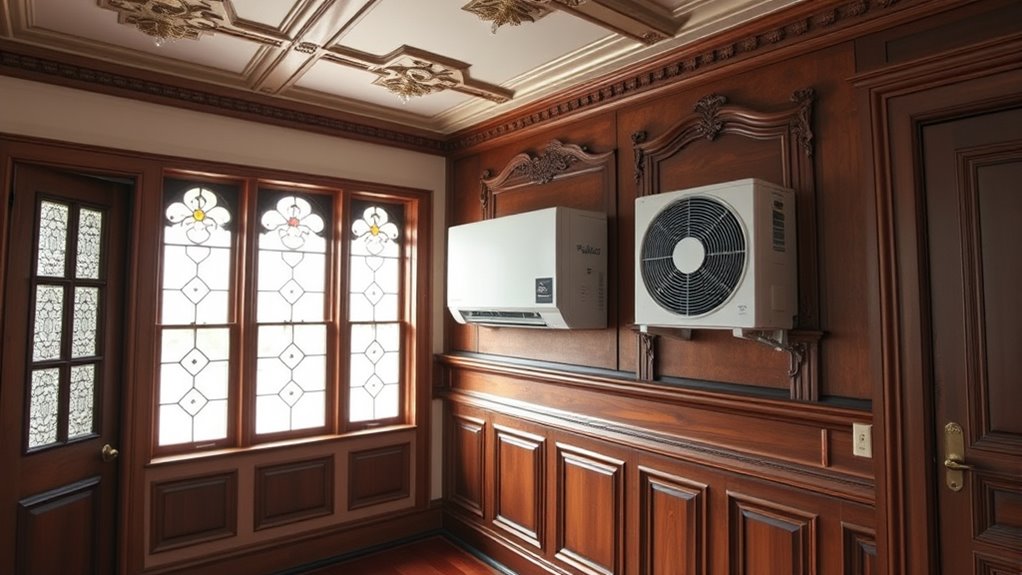
Ductless heat pumps help you maintain your home’s original architectural details by avoiding bulky ductwork that can damage walls and ceilings. Their flexible installation options let you add efficient heating and cooling without sacrificing historic features. Plus, these systems offer energy savings that help preserve your home’s character while reducing operational costs. Incorporating Gold IRA rollovers can also be a strategic way to diversify your retirement investments while maintaining your home’s historic integrity.
Preserves Architectural Details
Without the need for bulky ductwork, ductless heat pumps allow you to preserve the intricate architectural details of your historic home. Traditional HVAC systems often require modifications that can damage or obscure original features, but ductless systems install discreetly, avoiding such disruptions. This means you can maintain the authentic appearance of moldings, crown molding, and decorative ceiling details. Additionally, modern insulation paired with smart thermostats ensures efficient heating without invasive retrofits. You can control your home’s temperature precisely, which enhances comfort while protecting architectural integrity. By choosing ductless heat pumps, you respect your home’s historic charm and avoid altering its unique character, ensuring that your home’s beauty remains intact for generations to come. High performance systems also contribute to energy efficiency and long-term savings.
Flexible Installation Options
Because they don’t require extensive ductwork, ductless heat pumps offer remarkable flexibility in installation, especially in historic homes where preserving existing structures is a priority. This flexibility simplifies HVAC planning by eliminating the need for invasive ductwork installation, which can damage walls or ceilings. Ductwork alternatives like wall-mounted units or discreet indoor air handlers can be placed almost anywhere, ensuring minimal disruption to your home’s original design. You can install these systems in rooms where traditional HVAC setups would be challenging or impossible, saving space and maintaining aesthetic integrity. Additionally, the installation options for ductless systems allow for tailored solutions that can adapt to various architectural features, making them an ideal choice for preserving the character of your historic home while upgrading to efficient heating and cooling solutions.
Energy Efficiency Gains
The flexibility of installing ductless heat pumps in historic homes not only helps preserve their original aesthetic but also offers significant energy efficiency benefits. With smart thermostats, you can optimize heating and cooling, reducing energy waste and lowering utility bills. Ductless systems target specific rooms, avoiding the energy losses common with traditional ductwork. Additionally, insulation upgrades enhance overall efficiency by keeping conditioned air inside and reducing the workload on your heat pump. These improvements work together to create a more sustainable system that maintains comfort without compromising your home’s historic character. By choosing ductless heat pumps, you maximize energy savings while protecting the architectural integrity of your home. This balanced approach ensures you enjoy modern efficiency without sacrificing vintage charm. Implementing proper quality assurance practices in selecting and maintaining your system can ensure long-term performance and satisfaction.
Key Factors to Consider When Selecting a Heat Pump System for Your Historic Home

Choosing the right heat pump for your historic home requires careful consideration of several key factors. First, assess your home’s thermal insulation; well-insulated walls and ceilings improve efficiency and reduce strain on the system. Since historic preservation often limits structural changes, select a heat pump that fits your home’s unique architecture without extensive modifications. Compatibility with existing systems and the home’s overall energy demands are vital. You’ll also want to consider the size and capacity of the unit to guarantee it provides adequate heating and cooling. Additionally, choose a system that minimizes noise and vibration to avoid disturbing your home’s character. Paying attention to aesthetic integration ensures the system remains unobtrusive and maintains your home’s visual integrity. By focusing on these factors, you can select a heat pump that preserves your home’s historic integrity while offering efficient, modern comfort.
Tips for Professional Installation and Integration With Existing Structures
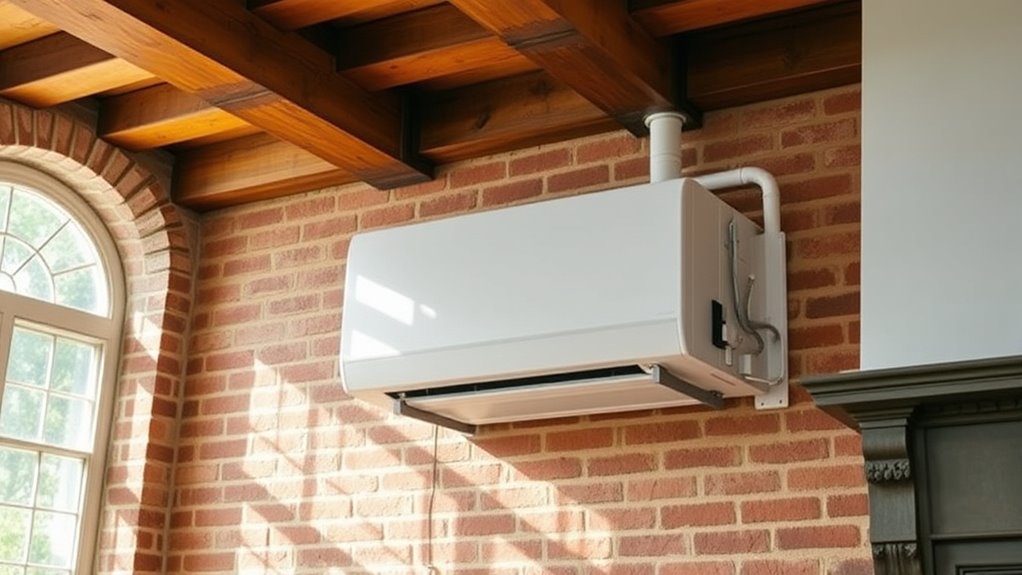
To guarantee your heat pump is installed correctly and seamlessly integrates with your existing structure, it’s essential to hire experienced professionals familiar with historic homes. They understand the importance of maintaining historic preservation standards while maximizing thermal insulation. Proper placement of the outdoor unit and careful routing of refrigerant lines prevent damage to delicate surfaces. Additionally, professionals can recommend non-invasive mounting options that preserve original features. Use this table to guide your installer:
| Consideration | Tip |
|---|---|
| Structural integrity | Avoid drilling into load-bearing walls |
| Thermal insulation | Enhance insulation before installation to boost efficiency |
| Preservation guidelines | Follow local historic preservation requirements |
| Vent placement | Minimize visual impact with discreet positioning |
| Integration with existing systems | Coordinate with existing electrical and plumbing setups |
Choosing the right team ensures your system respects your home’s character while performing at its best.
Maintaining Efficiency and Comfort While Respecting Historic Preservation Guidelines

Maintaining energy efficiency and indoor comfort in historic homes requires careful balancing with preservation guidelines. You want to honor the building’s historical significance while ensuring modern comfort and efficiency. Preservation challenges often limit structural modifications, so you must choose heat pump systems that minimally impact the original architecture. Opt for discreet, non-invasive installation methods that respect historic materials and features. To maximize efficiency, insulate properly and use programmable thermostats to reduce energy waste. Regular maintenance helps your system perform ideal without compromising the home’s integrity. By thoughtfully integrating modern heating solutions, you preserve the home’s character while achieving reliable comfort and energy savings, all without violating preservation guidelines. It’s about blending innovation with reverence for the past.
Frequently Asked Questions
Can Heat Pumps Be Installed Without Damaging Historic Wall Finishes?
You wonder if heat pumps can be installed without damaging historic wall finishes. With proper wall preservation, expert installation techniques guarantee minimal impact on your home’s aesthetics. Professionals use methods like surface-mounted units or minimally invasive wiring, preserving the integrity of your historic walls. These approaches allow efficient heating without sacrificing the charm or historic value of your home, making it possible to modernize comfortably while respecting your property’s character.
How Do Heat Pumps Affect the Resale Value of Historic Homes?
They say a stitch in time saves nine, but installing heat pumps can have mixed effects on your historic home’s resale impact. If done thoughtfully, it can boost comfort without harming historic charm, positively influencing the historic appraisal. However, improper installation might raise concerns among buyers or appraisers, potentially lowering resale value. So, guarantee expert installation to preserve your home’s character and maximize its market appeal.
Are There Specific Noise Level Considerations for Heat Pumps in Heritage Properties?
You should consider noise levels and acoustic considerations when installing heat pumps in heritage properties. These systems can generate sound that might disturb the historic ambiance or nearby neighbors. To minimize impact, choose models with low noise emissions and guarantee proper placement away from quiet spaces. Checking local regulations on noise levels is also essential to ensure your installation respects the property’s historic integrity and community standards.
What Are the Long-Term Maintenance Requirements for Ductless Heat Pumps?
Think of your ductless heat pump as a trusted garden companion. To keep it thriving, you’ll need routine filter changes and refrigerant maintenance, like watering and pruning. These tasks prevent buildup and guarantee efficiency, helping your system perform beautifully for years. Regular care is essential, especially in historic homes where preserving integrity is key. Staying proactive keeps your heat pump functioning smoothly, protecting your cherished space while providing comfort.
Do Heat Pumps Qualify for Preservation or Energy Efficiency Incentives?
You might qualify for tax incentives or preservation grants if you install a heat pump, especially if it boosts energy efficiency while respecting your home’s historic integrity. Check local and federal programs, like energy rebates or preservation grants, as they often support eco-friendly upgrades. Keep in mind, documentation proves your project’s compliance, making it easier to access these financial benefits and preserve your home’s character.
Conclusion
By choosing ductless or mini-split heat pumps, you protect your home’s historic charm, improve energy efficiency, and enjoy modern comfort. You preserve architectural integrity, simplify installation, and reduce invasive modifications. You embrace sustainable solutions, respect preservation guidelines, and create a cozy, efficient space. Ultimately, you balance innovation and tradition, comfort and conservation, modernity and history—making your home both timeless and functional for years to come.






